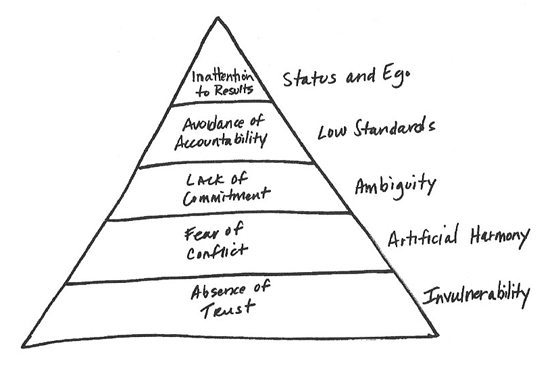Welcome to the e27 Tea Talk, where we talk about everything startup ecosystem.

It’s Friday afternoon, and you know what it means, it’s Tea Talk time!
It’s good to see you back, I hope you had a great time with Norman last Friday. How has your week been?
Let me tell you, it is H-E-C-T-I-C here in e27. We are in ‘wartime’ now as we are only 5 days away from the application deadline of TOP100 APAC Programme on February 14th! Yes, Valentines’ Day has a completely different meaning to us this year. But who needs a date when we have each other, am I right?
Only in times of chaos like this do we understand the power of teamwork. Let’s think about this for a moment. Teamwork should be the most ancient topic of Management 101s, yet until this day, it is still an aching problem for every company whether corporate or startup.
So, how do you know if you have a solid team? And how do you develop one?
1. Identify the underlying dysfunctions of a team
Has anyone ever heard of the book “The Five Dysfunctions of a Team” by Patrick Lencioni? If you haven’t, you should definitely check it out. I believe this is an essential piece of reading for everyone, especially those at the management level.
To illustrate, here the pyramid of the five dysfunctions of a team:

Photo source: Leadership Champs
The pyramid describes five issues that a team might experience in terms of trust, conflict, commitment, accountability, and results. The hindrance they cause is noted on the right hand side of the pyramid.
I was introduced to this pyramid during my first days at e27. And I admit, I was struck by how accurately it describes my professional behaviour.
Let’s take a minute to look at it. Can you and your team relate to any of these issues?
You don’t need to be at a leadership level to be able to identify these underlying problems. But as cliché as it sounds, you certainly need to take the lead to be the change you would like to see in others.
2. Conflict and commit.
I feel the need to do another reference to Patrick Lencioni’s book to assert my point, as I don’t think I can find a way to express it any better:
“A fractured team is just like a broken arm or leg; fixing it is always painful, and sometimes you have to re-break it to make it heal correctly. And the re-break hurts a lot more than the initial break, because you have to do it on purpose”
Yes, as painful as it is, it has to be done.
We all have the tendency to avoid conflicts because of the fear of turning the meeting or the discussion into a warzone. If you look at the pyramid again, you will see that the fear of conflict is dysfunction #2. Team members need to understand that without conflicts, they will not be aware of each other’s opinions or perspectives, which may lead to a failure to commit fully. This creates the so-called ‘artificial harmony’ situation.
Also read: [e27 Tea Talk] How to be a successful startup community builder
After the first step of acknowledging the importance of conflict, a team needs to understand how to produce constructive conflict. Arguments of a constructive conflict should not be targeted against anyone in the team, but should be made in the best interest of the team as a whole and in a professional manner. It is the responsibility of every team member to make sure they are on the same page with everyone else when leaving the room.
The heat of the conflict might be uncomfortable at first, but trust me, just like muscle training, the reward after the burn will be a strong and healthy core (of your team).
3. Learn to be empathetic
I’m talking about empathy, not just sympathy.
Sympathy is expressing concern or care towards a person, hoping his/her situation will become better. Empathy is at a deeper level than that. Being empathetic means you are willing to put yourself in another person’s shoes and share the same emotions or perspectives with them, in order to fully understand what they are going through.
I consider empathy a precious form of feeling, which takes courage and persistence to achieve. Empathy within workplace is even more difficult to implement, especially if the problem does not lie within your range of responsibilities. The first step towards developing empathy is to keep an open mind and listen to the others’ stories. Remember, the trick here is to listen for the sake of understanding, not answering.
Also read: Solver teams sail, while cross-functional teams fail
Here is a very interesting article by HubSpot on how they train their employees to be more empathetic. I think a few solutions could be easily adopted. Let me know which is your favourite? Mine is Having bosses do other employees’ jobs for a day. MUAHAHAHA!
Kidding and big talks aside, it all comes down to little things. Lunch together, laughing together about the silliest of things, or simply listening closely to whoever is talking. Ask yourself, when was the last time you had a team outing together?
You could check out what we do here at e27. Behind all the ECHELON glamour, we are after all a bunch of goofs who would like to think that we like each other (ish).

The truth is, a one-size-fits-all guideline for this topic is like an unicorn; it simply doesn’t exist. But, fortunately, there is a close substitute to solve all the team bonding problems, which is to get a cat for the office. Works like a charm.
Let us know what other unconventional solutions you have in mind are, brownie points go to the most ironically effective ones.
TGIF everyone! Catch you later!
–
e27 Tea Talk is the weekly column managed by Tracy and Norman. We hope to see you join in on stimulating discussions and constructive feedback as we navigate through the startup journey together. 🙂
The post [e27 Tea Talk] Solid teamwork takes effort appeared first on e27.